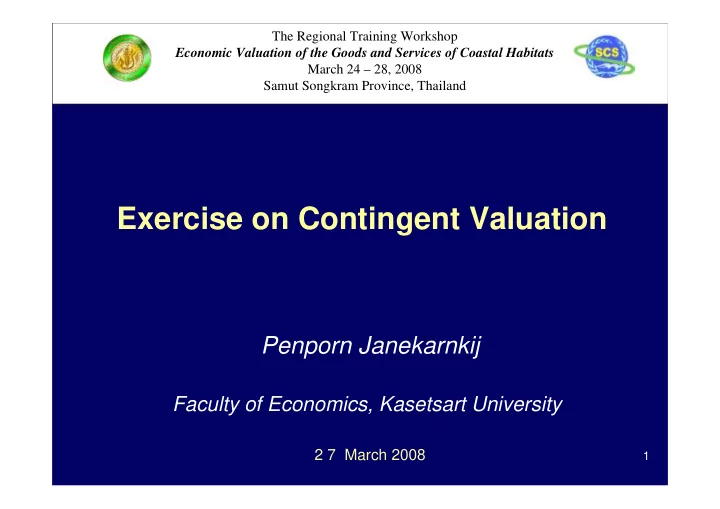

The Regional Training Workshop Economic Valuation of the Goods and Services of Coastal Habitats March 24 – 28, 2008 Samut Songkram Province, Thailand Exercise on Contingent Valuation Penporn Janekarnkij Faculty of Economics, Kasetsart University 2 7 March 2008 1
Outline • Policy and research questions • Scenario setting • Design of “offer/bid price” for dichotomous choice • Non-parametric model • Parametric model 2
Policy Question Policy Question The problem: AA Island is an important tourist destination of Thailand. Its tourism depends predominantly on coastal and marine biological resources. An establishment as a marine national park will help protect AA Island for further degradation. The policy question: The government wants to know the benefit of this program. 3
Specific research questions: 1. Will the citizen of Thailand accept and vote for the program? 2. If yes, how much WTP of each citizen for the protection and conservation of this island ? 3. What will be the non-use value of AA Island? Exercise : Estimate the citizen’s WTP using parametric and non-parametric model Basic information: The total population of Thailand is 65 million, with the employment rate of 60% in 2007 4
Contingent Valuation Method (CVM) Hypothetical market (situation) Trade- -off between $ and resource off between $ and resource Trade current situation hypothetical situation willing to pay for the protection not willing to pay (proposed scenario/condition with required payment) 5
Hypothetical market (situation) Trade- -off between $ and resource off between $ and resource Trade current situation hypothetical situation willing to pay to avoid the situation not willing to pay and accept the worse situation (proposed scenario/condition with required payment) 6
How to design the “bid price” in the survey of dichotomous choice? 1. Conduct “pre-survey” of residents with “open-ended question” If the situation is…. , how much in maximum would you be willing to pay: _______________ Baht/person/year. 2. Analyze data using “histogram” an design for the set of bid/offer price. 100 WTP 40 200 30 Baht/ 300 person/ 20 400 year 500 10 Frequency 600 0 5 20 100 300 500 1000 1500 4000 6000 13000 7 10 50 200 400 600 1200 2000 5000 10000 ….. WTP
Instruction: 1. Transform the data from the excel format to the SPSS format (from file: dichotomous_PJ.xls) 2. Get familiar with the data by checking for outliers, missing values, etc. 3. Using non-parametric model to estimate an average wtp/person/year 4. Using parametric model to estimate an average wtp/person/year 5. Conduct descriptive analysis and cross-tabulation analysis (note that there are some qualitative variables) 6. Calculate the mean WTP. 8
File: dichotomous_PJ.xls =>> example of variables Bid The offer/bid price (100, 200, 300, 400, 500, 600) wtp Response: yes = 1, no = 0 Method Payment mode: 1=bank transfer 2=bank check 3=postal check 4=credit card 5=cash 6=other modes Gender Male = 1, female = 0 Marital status single=0, married=1, divorced/separated=2 current income 0. Less than 5,000 Baht (Baht/month) 1. between 5,000 – 9,999 baht 2.between 10,000 – 14,999 Baht 3.between 15,000 – 19,999 Baht 4.between 20,000 – 24,999 Baht 5.between 25,000- 29,999 Baht 9 6. 30,000 Baht and above
Importing file: dichotomous_PJ.xls =>> SPSS format, then conduct descriptive analysis analyze/descriptive statistics/descriptives Socio-econ. No.of Percentage % sample willing to pay characteristic respondent Gender - female - male Occupation - govt employee - own business - ... - ... …………… 10 Total 100.00
Conduct cross-tabulation b/w “bid” and “wtp01” analyze/descriptive statistics/cross_tabs yes bid * wtp01 Crosstabulation wtp01 0 1 Total bid 100 Count 33 117 150 % within bid 22.0% 78.0% 100.0% 200 Count 40 110 150 % within bid 26.7% 73.3% 100.0% 300 Count 60 90 150 % within bid 40.0% 60.0% 100.0% 400 Count 70 80 150 % within bid 46.7% 53.3% 100.0% 500 Count 85 65 150 % within bid 56.7% 43.3% 100.0% 600 Count 113 37 150 % within bid 75.3% 24.7% 100.0% Total Count 401 499 900 11 % within bid 44.6% 55.4% 100.0%
Non-parametric estimation Bid level No.of sub- No.of sample %answer- WTP per group Description samples answering ing Y for “YES” each group 22.0% of people would have WTP b/w 0-100 B/yr 100 150 117 .78 200 300 400 18.6% of them would have 500 .433 WTP b/w 500-600 B/yr 24.7% of them would have 600 150 37 .247 WTP at least 600 B/yr 900 Calc.WTP for 900 Total samples 12
Calculation of the mean WTP: mean WTP/person = WTP of total samples / no.of total samples Plot graph for the probability function 1 0.9 0.8 0.7 Probabiliy 0.6 0.5 0.4 0.3 0.2 0.1 0 0 100 200 300 400 500 600 Bid price 13 Area under the curve signifies the mean WTP of a person.
Parametric estimation For simplicity, assumed the linear function with bivariate model: wtp = a 0 + a 1 bid 1. Calculate the mean WTP: mean WTP = - (a 0 /a 1 ) 2. Calculate the non-use value of AA Island: non-use value = mean WTP x total population 14
analyze/regression/binary logistics.. Results: from WTP = a - b BID We get: WTP = 1.847 – 0.005 BID Mean WTP = - (1.847 / 0.005) = ………….. B/person/yr. Compare results obtained from parametric and non-parametric models 15
Recommend
More recommend